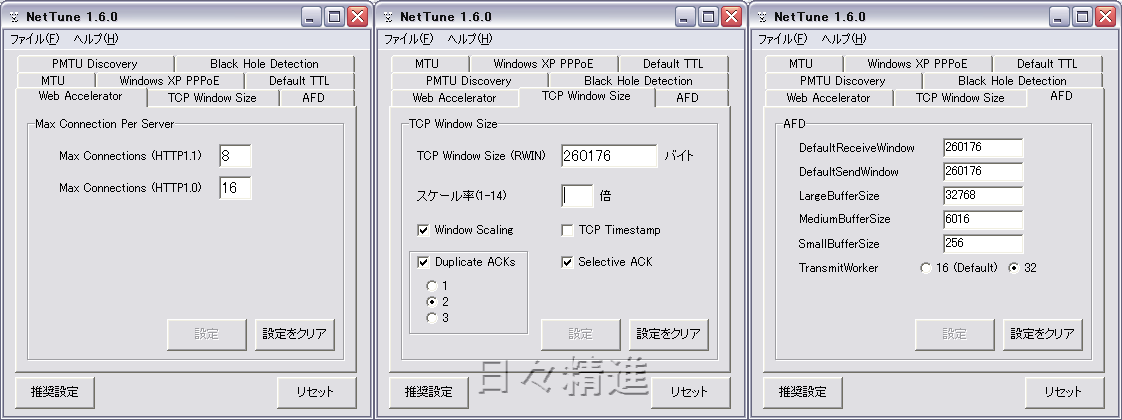

When set to 1 (True), TCP attempts to discover MTU automatically over the path to a remote host. Other settings that are widely used are 128 and 32) A value that’s too small can cause packets to be unable to reach distant servers at all.ĭefaultTTL=”64″ (DWORD, recommended setting is 64. While it does not directly affect speed, a larger value increases the amount of time it takes for a packet to be considered lost, discarded and retransmitted. Note: Tcp1323Opts=”3″ might help in some cases where there is increased packet loss, however generally you’ll achieve better throughput with Tcp1323Opts=”1″, since Timestamps add 12 bytes to the header of each packet.ĭefaultTTL determines the time in seconds and the number of hops a packet lives (every hop reduces it by at least 1). The possible settings are 0 – Disable RFC 1323 options, 1 – Window scaling but no Timestamp options, 3 – Window scaling and Time stamp options.) Tcp1323Opts=”1″ (DWORD, recommended setting is 1. Without this parameter, the TCP Window is limited to 64K. Tcp1323Opts is a necessary setting in order to enable Large TCP Window support as described in RFC 1323. If you choose to use a RWIN lower than 65535, you can simply make it multiple of MSS and turn scaling off (Tcp1323Opts=0). Note: For best results RWIN has to be a multiple of MSS lower than 65535 times a scale factor that’s a power of 2, i.e. TcpWindowSize can also exist under TcpipParametersInterface – if added at this location, it overrides the global setting for this particular NIC.

#Windows afd buffer defaultreceivewindow windows#
Note (10/20/00): Seems MS has found another bug in Windows 2000, the TCPWindowSize should be configured with the global setting (GlobalMaxTcpWindowsSize) rather than this one – Q263088 TcpWindowSize=”256960″ (DWORD, number of bytes) Valid range is from MSS to 2^30. HKLM\SYSTEM\CurrentControlSet\Services\Tcpip\Parameters If you choose to use a RWIN lower than 65535, you can simply make it multiple of MSS and turn scaling off (Tcp1323Opts=0) GlobalMaxTcpWindowSize=”256960″ (DWORD, number of bytes) Valid range is from MSS to 2^30.

HKLM/SYSTEM\CurrentControlSet\Services\Tcpip\Parameters There are three places in the Windows Registry where you can add the TCP Window parameter. To determine the exact MTU value of your ISP, check out the Advanced Registry Editing section of our site or use the TCP Optimizer. MTU is usually 1500 bytes (1492 for PPPoE connections). MSS is generally MTU – 40 (20 byte TCP and 20 byte IP headers), where MTU (Maximum Transmission Unit) is the largest packet size that can be transmitted. It will work well for most cases, however, if you’d like to use a custom value make sure to follow these guidelines: For best results, the TCPWindow should be a multiple of MSS (Maximum Segment Size).

The recommended value (in red) will optimize TCP for any high speed broadband internet connection. The value of the TCP Window in the Windows 2k/XP Registry is probably the single most importan setting that will offer the most benefit to improving your internet connection. HKEY_LOCAL_MACHINE\SYSTEM\CurrentControlSet\Services\Tcpip\Parameters The best settings are listed in red, the descriptions and other options are added to provide you with better understanding and enable you to customize your settings.Īll the following entries, unless otherwise noted should be placed in the Windows 2000/XP Registry under the key Windows 2000 & XP, unlike NT supports large windows as described in RFC1323 ( the ‘RcvWindow’ has a maximum value of 2**30 rather than 64K), and includes some other improvements over its predecessors you can use to speed up any TCP/IP transfers. Recommended settings for Windows 2000 / XP The easiest way to backup your Registry is from within the Registry Editor, just choose “Export Registry File” from the pull-down menu. It is strongly recommended that you backup your Registry before editing. Also, for most of the tweaks to take effect you must Reboot. Note that most of the values recommended on these pages are not present in the Registry by default and you might have to add them manually. As with previous Windows versions, it can be accessed from the Start Menu ( START > Run > type “Regedit” ). To edit the Registry, you need to use an editor, such as Regedit. If you’d rather make the changes yourself, or prefer to experiment with different values to fine-tune your connection, follow the directions for editing the Registry below. INI ADALAH KUMPULAN TRIKS YG SAYA DAPAT DI INTERNET, KALAU ANDA TDK MEMAHAMINYA.


 0 kommentar(er)
0 kommentar(er)
